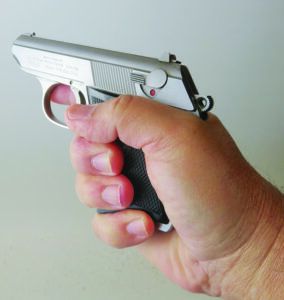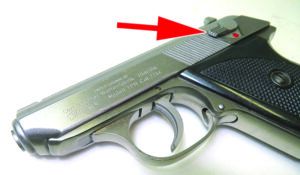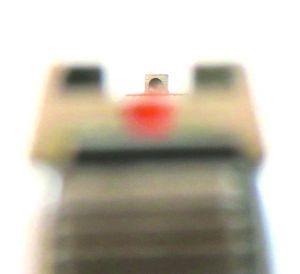An email from Gun Tests reader Jim T. asked for a 22 LR subcompact concealed-carry pistol match up, specifically mentioning the old-school Walther TPH and Ruger LCP II. We winced at the thought because the 22 LR is not an adequate defense round, in our estimation. There are better caliber choices, but 22 LR subcompact pistols are popular and have been since the 1920s. We added two additional subcompacts — a Taurus PT-22 and Beretta 21A Bobcat — to round out the list. Though these mouse guns lack power, they do offer deep concealment and surprise. These are close-quarter guns to be used an arm’s length away, perhaps incapacitating or intimidating your attacker so you can run away to safety or to get a bigger gun.
How We Tested
All of these pistols have short barrels less than 3 inches in length and have tiny, rudimentary sights. Because they are small, they tend to get lost in your hand. There is not a lot to hang onto. Slides are small with minimal serrations, especially in the case of the Taurus and Beretta, and that makes them difficult to operate. The Ruger LCP II was specially designed for ease of slide retraction. Safety levers are also minuscule, as are the magazines, which can be a pain to load.
We accuracy tested at 10 yards, using our range bag as a rest, and found the pea-shooters had good accuracy. We used Thompson Targets Sight-Seer Red targets for accuracy testing. For speed shooting, we performed the Failure Drill — two shots to center of mass, one shot to the head — at 7 yards and found all of these guns performed well and could easily be used to defend yourself. We tested speed using a Thompson Target B27STOP Upper Torso Silhouette Target, which has immobilization zones outlined on the sheet.

Now here’s the “but”: Getting a semi-automatic 22 LR pistol to run consistently is a challenge. There is an embarrassment of 22 LR bullet weights and styles, and some work better than others, depending on the pistol. We would definitely run a lot of 22 LR ammo through these mousey guns to find consistency before we pocketed any of them for defense. With the new guns — Beretta 21A Bobcat, Taurus PT-22, ad Ruger LCP II — we experienced FTF (failures to feed) jams and some FTE (failures to eject) jams, especially in early accuracy testing. The bullet shape makes a big difference on whether the ammo will feed or not. The Winchester Silvertip ammo gave us the most mishaps, and that could be because it uses a larger 37-grain bullet compared to the 30-grain and 29-grain bullets used in the Aguila and Federal ammo, respectively. As we ran ammo through them, they performed more consistently, so keep in mind there is a break-in period for the mouse guns.

We also concealed-carried these pistols in our pocket, using an Elite Survival System Pocket holster PH-1L ($18; EliteSurvival.com), which has a no-slip outside texture that “sticks” to the inside of your pants pocket and allows you to easily draw the pistol. The Ruger LCP II came with a similar style holster, which we thought was added value. All of these mouse guns were easy to carry concealed and simply felt like a wallet in our front pocket.
Test ammo for the mouse guns consisted of two defense loads that on paper make a mouse gun roar: Winchester Silvertips with a 37-grain plated segmenting hollow point bullet and Federal Punch, a 29-grain flat-point solid bullet. We also tested Aguila’s amped-up Supermaximum rounds with a 30-grain copper-plated solid bullet. With 22 LR ammo, you want a bullet to penetrate as much as possible for terminal performance. Heavy clothing and body mass will slow down a 22 LR, which means less penetration. Here are the details.
Gun Tests Grade: B-
$500-$1000
Our used Walther TPH (Taschen Pistole, Hahn, which translates to “pocket pistol, hammer”) was built out of stainless steel in the U.S. for Interarms. The design was introduced in 1968, but the 1968 Gun Control Act did not allow this pea-shooter to be imported into the country. In 1978, U.S. manufacturers, under license from Walther, began manufacturing the TPH. Production in the U.S. ceased in 2000. Too bad. This is another elegant European design produced at a time when all pistols had metal frames.
| Action | Semi-automatic, blowback, hammer fired |
| Trigger | Double action/Single Action |
| Overall Length | 5.3 in. |
| Overall Height | 3.7 in. |
| Maximum Width | 0.9 in. |
| Weight Unloaded | 11.5 oz. |
| Weight Loaded | 12.2 oz. |
| Barrel Length | 2.8 in. |
| Capacity (single stack) | 7+1 |
| Slide | Matte stainless, stainless steel |
| Slide Retraction Effort | 10.0 lbs. |
| Frame | Matte stainless, stainless steel |
| Frame Front Strap Height | 1.7 in. |
| Frame Back Strap Height | 2.1 in. |
| Grip | Checkered polymer |
| Grip Thickness (max) | 0.9 in. |
| Grip Circumference (max) | 4.5 in. |
| Sights | Fixed, drift adj. rear |
| Trigger Pull Weight Double Action | 12.0 lbs. |
| Trigger Pull Weight Single Action | 2.9 lbs. |
| Trigger Span Double Action | 2.6 in. |
| Trigger Span Single Action | 2.3 in. |
| Magazines | 1; steel |
| Manual Safety | Decocker, half-cock, inertia firing pin |
| Warranty | NA |
| Website | WaltherArms.com |
| Made In | USA (Interarms) |
It is similar to the PPK/S with a simple blowback action, full metal grip frame, external extractor, decocking lever on the slide, and rounded serrated hammer. The TPH has a magazine catch located at the bottom of the frame, and you need to pull the magazine free from the pistol. It pops out about an inch and then you need to do the rest. Loading the magazine is similar to loading a centerfire magazine. There is not a load-assist button.
In hand, the TPH feels thin and sits low. The slide and hammer are close to your hand. We had no issues with hammer/slide bite, but a ham-fisted user might. We could only get two fingers on the smooth front grip strap with our small finger curled under the magazine floor plate. It pointed a bit high, and we liked that because we could pick up the front sight better. The front sight post is machined from the slide, but the rear sight can be tapped left or right to adjust windage. There was a red dot under the rear-sight notch to aid in sight alignment. We liked these sights a lot. The top of the slide was decoratively machined with that wavy pattern old-school Walthers are known for. There was plenty of slide serrations to rack the slide, and it only took 10 pounds of effort.

In the manual of arms, press the decocking lever down and the hammer moves forward and also disconnects the trigger. There is a half-cock safety, and that is how we carried the TPH.
In the accuracy test, the TPH performed well. Its best group measured 1.32 inches with the Aguila Supermaximum ammo. In single-action mode, the trigger broke at 2.9 pounds. We had no issues with any ammo during the accuracy test, and we attribute that to the used pistol being well broken in. Moving on to the Failure Drill, we had a few jams with the Winchester Silvertip. The DA trigger pull was a weighty 12 pounds, so the first shot was slow to target. The two following shots were fast and precise. The trigger is serrated, and that made sure the pad of our finger did not slip on the trigger.
Carrying the TPH concealed was easy and comfortable, and it weighed as much as the Ruger loaded with 10 rounds. The rear of the slide was fairly smooth, and we kept our thumb on the hammer when drawing the pistol from our pocket.
Our Team Said: The TPH has Walther prestige, and you pay for that reputation, even in a used gun. We liked how the TPH performed, and the accuracy was good. The DA trigger pull was too heavy, in our opinion, causing a delay with the first shot. Loaded with Aguila or Federal rounds, the TPH would work as a defensive mouse gun.
22 LR Range Data
To collect accuracy data, we fired five-shot groups from a bench using a rest. Distance: 10 yards with open sights. We recorded velocities using a ProChrono digital chronograph set 15 feet from the muzzle.| Winchester Silvertip 37-grain Segmented HP | Ruger LCP II | Taurus PT-22 | Beretta 21A Bobcat | Walther TPH |
| Average Velocity | 938 fps | 873 fps | 907 fps | 948 fps |
| Muzzle Energy | 72 ft.-lbs. | 63 ft.-lbs. | 68 ft.-lbs. | 74 ft.-lbs. |
| Smallest Group | 1.20 in. | 1.08 in. | 2.28 in. | 2.15 in. |
| Average Group | 1.61 in. | 1.19 in. | 2.56 in. | 2.48 in. |
| Federal Punch 29-grain Flat SP PO22L1 | Ruger LCP II | Taurus PT-22 | Beretta 21A Bobcat | Walther TPH |
| Average Velocity | 1111 fps | 1027 fps | 1045 fps | 1141 fps |
| Muzzle Energy | 79 ft.-lbs. | 68 ft.-lbs. | 70 ft.-lbs. | 75 ft.-lbs. |
| Smallest Group | 0.80 in. | 1.05 in. | 2.17 in. | 1.35 in. |
| Average Group | 1.50 in. | 1.19 in. | 2.69 in. | 1.60 in. |
| Aguila Supermaximum 30-grain Flat SP | Ruger LCP II | Taurus PT-22 | Beretta 21A Bobcat | Walther TPH |
| Average Velocity | 915 fps | 870 fps | 919 fps | 1065 fps |
| Muzzle Energy | 56 ft.-lbs. | 50 ft.-lbs. | 56 ft.-lbs. | 76 ft.-lbs. |
| Smallest Group | 1.47 in. | 2.88 in. | 1.79 in. | 1.32 in. |
| Average Group | 1.73 in. | 3.16 in. | 2.08 in. | 1.42 in. |


























Mr. Sadowski, Excellent review as are all your writings. All I can add is, if you want to truly enjoy a State respecting your Second Amendment rights, consider South Carolina. Have a great day and looking forward to your next article.
Why is this tagged as a ‘rifle’?
Also, I’m surprised that CCI MiniMags weren’t used in testing or even the CCI Stingers. I don’t carry a .22 for self defense, but if I had to, I’d be going with 40 grain MiniMags for both reliability and penetration.
Agree!
A number of years ago, I owned 3 Walther. A PP in .380, a PPKs in 380, and a .22 though I can’t remember the model.
The PP was a beautiful blued gun, which I any rarely. The PPKs had a nasty habit during recoil where the slide cut 2 neat cuts in the web of my hand – after this I only shot it rarely much more. The .22 was a neat Pistol, which I became less enchanted with when the rear sight fell.
Needless to say all of the Walther and I parted way. I only wish I would have kept the PP.
I really hate spellcheck!
got my iver johnson tp22 in the early 80s, i have put 1000s of rounds of stingers thru it with zero malfunctions. i still carry it around the farm, and it still takes out varmints regularly. a skilled shooter with this “mouse gun” is still adequately armed for nearly any situation
I liked the article and I have a 22LR pocket pistol. But I like my S&W Bodyguard 380 – which is about the same size and weight – much better!
Oh, and my S&W 380 has a built-in Laser . . . .
I often carry the TPH in my right front pocket, no holster though. I carry it with the hammer down and safety off – that heavy DA trigger pull ensures the trigger won’t be accidentally pulled. The TPH’s preferred round, and mine, is the CCI Mini Mag HP. I practice neck and face shots on the NRA TQ-20 target at 3-yards.
As an easily concealed, last ditch, close in (handshake distance) defense pistol I have a lot of confidence in it.